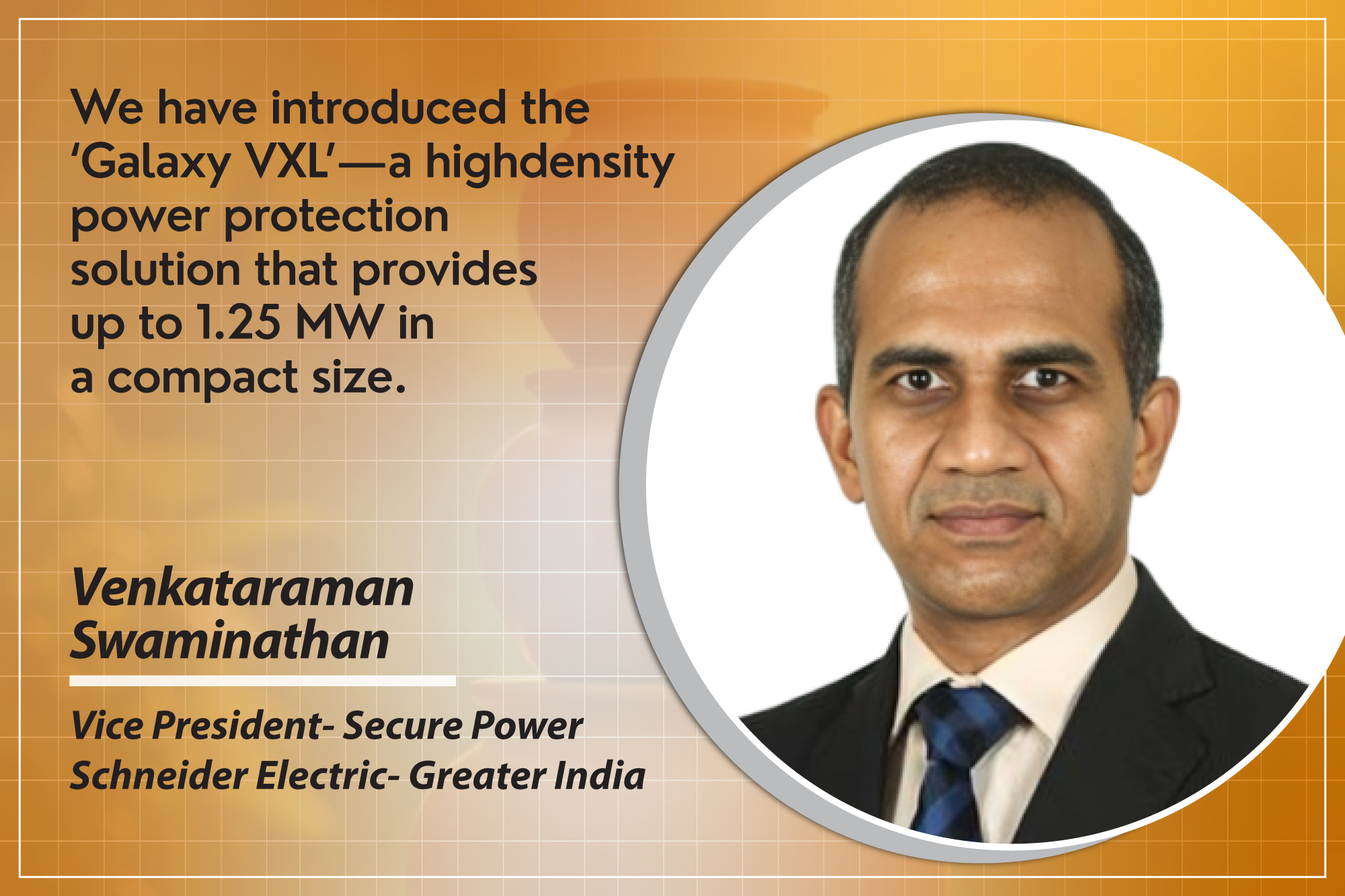Schneider AI-led EcoStruxure strengthening power resilience in Data Centres
By Staff Report August 23, 2025 12:55 pm IST
By Staff Report August 23, 2025 12:55 pm IST

This software helps to continuously monitor and optimise energy flows across locations, enabling predictive maintenance and significantly reducing the risk of downtime, especially in areas with unstable grid conditions.
The digital infrastructure in India is facing resilience, energy and sustainability challenges. The Data Centre sector, in particular, needs high and consistent energy. Here, Schneider Electric can be seen addressing these issues with state-of-the-art innovations. Venkataraman Swaminathan shares more in talks with EPR. Let us know from him.
How are AI-enabled platforms and microgrid architectures enhancing resilience and uptime for data centres in India’s unstable grid regions?
The extensive geographic and infrastructure diversity of India creates unique challenges for data centre resilience. We are tackling this directly by implementing AI-enabled infrastructure software like ‘EcoStruxure’. This software helps us continuously monitor and optimise energy flows across locations, enabling predictive maintenance and greatly reducing the risk of downtime, especially in areas with unstable grid conditions.
We are also adapting to the increasing demand in Tier 2 and Tier 3 cities, where power supply can be unreliable. Our microgrid-compatible architecture, which combines solar, battery and diesel inputs, ensures dependable operations while reducing reliance on unpredictable energy sources. As the demand for AI-ready and edge data centres is on the rise, our modular architecture provides scalable capacity without compromising uptime. This reflects our dedication to creating smarter and more resilient digital infrastructure across India.
How can Schneider Electric transform grid stability and energy efficiency for India’s digital infrastructure?
In India, Battery Energy Storage Systems are transitioning from merely backup solutions to active contributors to grid stability and energy efficiency. We are spearheading this evolution with our lithium-ion BESS technology, which provides higher energy density, thermal stability and long-term cost advantages over traditional VRLA systems. These qualities are particularly important in high-temperature areas and when energy prices fluctuate.
What’s truly transformative is how our ‘EcoStruxure’ software integrates with BESS. It uses AI to manage energy flows in real time, automatically adjusting loads based on demand forecasts and the variability of renewable sources like solar. This means data centres can maintain uninterrupted operations even during grid outages or peak demand periods without needing manual intervention. It is a decisive step toward building resilient and sustainable infrastructure for the digital future of India.
Which recent innovation has Schneider Electric come up with to address space and sustainability challenges in the evolving hyperscale and edge data centre landscape?
India is quickly advancing toward hyperscale and edge data centre models, and so the demand for UPS systems is changing. We have introduced the ‘Galaxy VXL’—a high-density power protection solution that provides up to 1.25 MW in a compact size. This is especially important for urban data centres, which have limited space.The Galaxy VXL is modular by design with hot-swappable components that simplify maintenance and reduce mean time to repair. We have also integrated lithium-ion batteries, which help lower the total cost of ownership by minimising cooling needs and extending replacement cycles.
Furthermore, its ECOnversion mode achieves up to 99 per cent efficiency, making it a reliable and sustainable power solution. It perfectly aligns with the national green data centre goals and policy frameworks focused on energy efficiency and carbon reduction.
How can India overcome legacy infrastructure, skills gaps and regulatory uncertainty to accelerate the transition from AC to DC data centres?
Transition from AC to DC architecture in data centres in India is progressing gradually due to three major challenges: legacy infrastructure, a limited pool of DC-trained professionals and the lack of clear regulatory standards. Most facilities are still based on AC systems, making retrofitting for DC both technically complex and costly.
However, we are actively working to accelerate this transition. We are collaborating with leading hyperscalers on pilot projects that incorporate DC-integrated racks and renewable-powered subsystems. These setups are already demonstrating promising results, especially in reducing conversion losses and improving PUE. We are also working with industry bodies to help establish standards that ensure safety, interoperability and grid compliance for DC systems. It is a crucial step toward unlocking the full potential of DC architecture in India’s data centre landscape.
How can policy incentives and green certifications drive sustainable growth in India’s AI-driven data centre sector?
The AI-led digital growth is spurring a wave of policy reforms, particularly in the data centre sector. States like Uttar Pradesh, Maharashtra and Tamil Nadu are already implementing incentive policies that include tax benefits, expedited approvals and requirements for renewable energy sourcing. We are actively collaborating with both central and state agencies to promote the development of green data centre certification frameworks.
Our partnership with NVIDIA to develop AI factories exemplifies how private innovation aligns with public digital goals. These facilities feature advanced energy and cooling systems that support large-scale AI and cloud operations while reducing environmental impact. It serves as a model for how India can expand its digital infrastructure sustainably.
We use cookies to personalize your experience. By continuing to visit this website you agree to our Terms & Conditions, Privacy Policy and Cookie Policy.